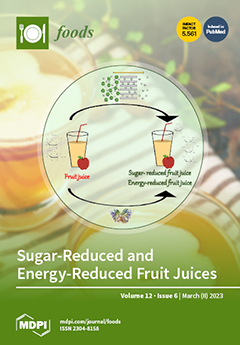Antimicrobial resistance is an existential threat to the health sector, with far-reaching consequences in managing microbial infections. In this study, one hundred and ninety-four
Listeria monocytogenes isolates were profiled for susceptibility using disc diffusion techniques. Possible foodborne listeriosis risk associated with ready-to-eat (RTE)
[...] Read more.
Antimicrobial resistance is an existential threat to the health sector, with far-reaching consequences in managing microbial infections. In this study, one hundred and ninety-four
Listeria monocytogenes isolates were profiled for susceptibility using disc diffusion techniques. Possible foodborne listeriosis risk associated with ready-to-eat (RTE) foods (RTEF) and the risk of empirical treatment (EMPT) of
L. monocytogenes infections, using multiple antimicrobial resistance indices (MARI) and antimicrobial resistance indices (ARI), respectively, were investigated. Twelve European Committee on Antimicrobial Susceptibility Testing (EUCAST) prescribed/recommended antimicrobials (EPAS) for the treatment of listeriosis and ten non-prescribed antimicrobials (non-PAS)] were evaluated. Antimicrobial resistance > 50% against PAs including sulfamethoxazole (61.86%), trimethoprim (56.19%), amoxicillin (42.27%), penicillin (41.24%), and erythromycin (40.21%) was observed. Resistance > 50% against non-PAS, including oxytetracycline (60.89%), cefotetan (59.28%), ceftriaxone (53.09%), and streptomycin (40.21%) was also observed. About 55.67% and 65.46% of the isolates had MARI scores ranging from 0.25–0.92 and 0.30–0.70 for EPAs and non-PAs, respectively. There was a significant difference (
p < 0.01) between the MARI scores of the isolates for EPAs and non-PAs (means of 0.27 ± 0.21 and 0.31 ± 0.14, respectively). MARI/ARI scores above the Krumperman permissible threshold (>0.2) suggested a high risk/level of antimicrobial-resistant
L. monocytogenes. The MARI risks of the non-success of empirical treatment (EMPT) attributed to EPAs and non-PAs were generally high (55.67% and 65.463%, respectively) due to the antimicrobial resistance of the isolates. MARI-based estimated success and non-success of EMPT if EUCAST-prescribed antimicrobials were administered for the treatment of listeriosis were 44.329% and 55.67%, respectively. The EMPT if non-prescribed antimicrobials were administered for the treatment of listeriosis was 34.53% and 65.46%, respectively. This indicates a potentially high risk with PAs and non-PAs for the treatment of
L. monocytogenes infection. Furthermore, ARI scores ≤ 0.2 for EPAs were observed in polony, potato chips, muffins, and assorted sandwiches, whereas ARI scores for non-PAs were >0.2 across all the RTE food types. The ARI-based estimate identified potential risks associated with some RTE foods, including fried fish, red Vienna sausage, Russian sausage, fruit salad, bread, meat pies, fried chicken, cupcakes, and vetkoek. This investigation identified a high risk of EMPT due to the presence of antimicrobial-resistant
L. monocytogenes in RTE foods, which could result in severe health consequences.
Full article






